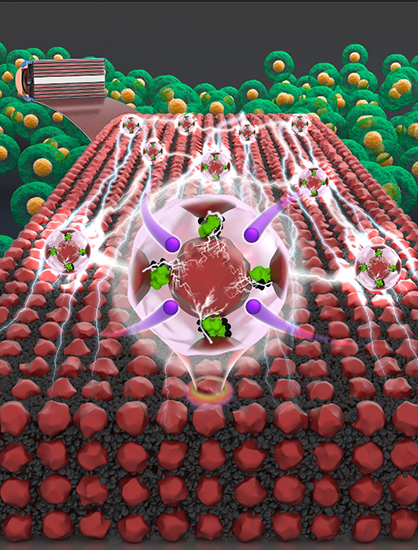Significance
Lithium-ion batteries have become a cornerstone of modern energy storage technology due to their high energy density, long cycle life, and versatility in various applications. They play a crucial role in powering everything from smartphones and laptops to electric vehicles and renewable energy systems. Central to their performance is the electrode, where the interplay between active materials (AM) and binders governs electrochemical efficiency. A recent study published in the peer reviewed Journal Advanced Energy Materials, by Professors Xuewei Fu, Wei Yang, and Yu Wang from Sichuan University, Chengdu, China, sheds light on a novel paradigm by elucidating the intricate role of the microenvironment surrounding active materials (ME@AM) within battery electrodes. The new study’s findings have important implications for advancing energy storage technology.
Traditionally, the focus has been primarily on the active materials themselves, with little attention paid to their microenvironment in which they operate. However, recent investigations reveal that the microenvironment surrounding these active materials significantly influences their performance. A dynamic interplay between binder characteristics, dispersion of nanoparticles, and microstructural organization is identified as the crux of this interaction. The composition and quality of ME@AM have a direct bearing on the ion and electron transport efficiency within the electrode, ultimately determining the battery’s overall performance.
A notable contribution of the authors is the introduction of the sol-binder, exemplified by polyvinylidene fluoride (PVDF). Unlike conventional solution-based binders, the sol-binder leverages the sol-to-gel transition, revealing a unique and intriguing working mechanism. The sol-binder manifests as a three-stage process involving liquid, gelation, and solidification, offering distinct advantages in binder distribution and nanoparticle dispersion. By virtue of this behavior, the sol-binder suppresses component separation and aggregation during drying, leading to more uniform and efficient microstructures.
The research team introduced novel methods to assess the mechanical stability of ME@AM. Compression-relaxation testing and cycle bending testing provide insights into the electrode’s resilience under varying mechanical conditions. The PVDF sol-binder demonstrates remarkable mechanical stability, resisting liquid electrolyte wetting and mechanical deformation. This advancement in characterization techniques showcases the importance of mechanical stability in battery electrodes and sets the stage for more comprehensive assessments.
The authors proposed a paradigm shift where the quality of ME@AM becomes a cornerstone criterion for binder selection, processing parameters, and electrode performance. The concept of “healthy ME@AM” represents a unifying principle that underpins the optimization of electrode microstructures. By focusing on achieving ideal microenvironments, researchers can pave the way for enhanced battery electrode design, performance, and longevity.
The sol-binder’s unique characteristics offer exciting opportunities in electrode fabrication, especially for high-energy-density electrodes with lean binder content and high AM loading. The authors demonstrated that the sol-binder system’s thixotropic properties enable the creation of 3D-printed electrode architectures. This innovation not only enhances charge transport capabilities but also showcases the potential for designing intricate electrode structures for improved performance.
The authors finding has far-reaching implications for the field of energy storage and beyond. The introduction of sol-binders as an innovative approach to binder design challenges existing notions and opens avenues for further research. The concept of “healthy ME@AM” introduces a holistic framework for electrode optimization and performance enhancement. Future research directions could explore the potential of sol-binders in different chemistries, electrode architectures, and scale-up manufacturing processes. Additionally, the study’s characterization techniques could inspire the development of new methods for assessing the mechanical stability of various materials and systems.
The new study on microenvironment engineering and sol-binder design marks a significant milestone in the advancement of energy storage technology. The recognition of the ME@AM’s pivotal role in battery electrode performance calls for a paradigm shift in binder selection and electrode design. The sol-binder’s distinctive properties and working mechanism present exciting prospects for enhancing the efficiency, reliability, and sustainability of lithium-ion batteries. As we navigate the path toward more efficient and eco-friendly energy storage solutions, this study serves as a guiding light, illuminating the way for innovative research and technology development.
In conclusion, the investigation into ME@AM and sol-binders by Sichuan University researchers underscores the importance of interdisciplinary approaches in engineering research. By recognizing the intricacies of material interactions and harnessing novel binder design concepts, we inch closer to realizing the full potential of energy storage technology and contributing to a greener, more sustainable future.

Reference
Yan He, Lei Jing, Lanxiang Feng, Sifan Yang, Jiarui Yang, Xuewei Fu,* Wei Yang,* and Yu Wang* A Smart Polymeric Sol-Binder for Building Healthy Active-Material Microenvironment in High-Energy-Density Electrodes. Adv. Energy Mater. 2023, 13, 2203272.
 Advances in Engineering Advances in Engineering features breaking research judged by Advances in Engineering advisory team to be of key importance in the Engineering field. Papers are selected from over 10,000 published each week from most peer reviewed journals.
Advances in Engineering Advances in Engineering features breaking research judged by Advances in Engineering advisory team to be of key importance in the Engineering field. Papers are selected from over 10,000 published each week from most peer reviewed journals.




